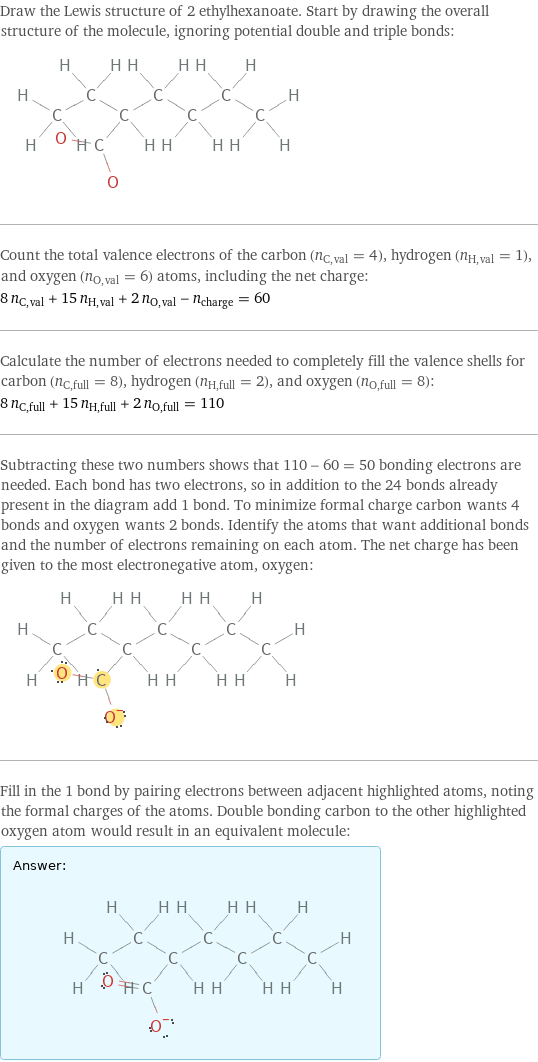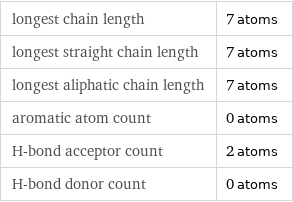Input interpretation

2 ethylhexanoate
Basic properties
![molar mass | 143.2 g/mol formula | (C_8H_15O_2)^- empirical formula | C_8O_2H_15 SMILES identifier | CCCCC(CC)C(=O)[O-] InChI identifier | InChI=1/C8H16O2/c1-3-5-6-7(4-2)8(9)10/h7H, 3-6H2, 1-2H3, (H, 9, 10)/p-1/fC8H15O2/q-1 InChI key | OBETXYAYXDNJHR-UHFFFAOYSA-M](../image_source/ed42eb862c91e42ece1ad5282fb9b675.png)
molar mass | 143.2 g/mol formula | (C_8H_15O_2)^- empirical formula | C_8O_2H_15 SMILES identifier | CCCCC(CC)C(=O)[O-] InChI identifier | InChI=1/C8H16O2/c1-3-5-6-7(4-2)8(9)10/h7H, 3-6H2, 1-2H3, (H, 9, 10)/p-1/fC8H15O2/q-1 InChI key | OBETXYAYXDNJHR-UHFFFAOYSA-M
Lewis structure

Draw the Lewis structure of 2 ethylhexanoate. Start by drawing the overall structure of the molecule, ignoring potential double and triple bonds: Count the total valence electrons of the carbon (n_C, val = 4), hydrogen (n_H, val = 1), and oxygen (n_O, val = 6) atoms, including the net charge: 8 n_C, val + 15 n_H, val + 2 n_O, val - n_charge = 60 Calculate the number of electrons needed to completely fill the valence shells for carbon (n_C, full = 8), hydrogen (n_H, full = 2), and oxygen (n_O, full = 8): 8 n_C, full + 15 n_H, full + 2 n_O, full = 110 Subtracting these two numbers shows that 110 - 60 = 50 bonding electrons are needed. Each bond has two electrons, so in addition to the 24 bonds already present in the diagram add 1 bond. To minimize formal charge carbon wants 4 bonds and oxygen wants 2 bonds. Identify the atoms that want additional bonds and the number of electrons remaining on each atom. The net charge has been given to the most electronegative atom, oxygen: Fill in the 1 bond by pairing electrons between adjacent highlighted atoms, noting the formal charges of the atoms. Double bonding carbon to the other highlighted oxygen atom would result in an equivalent molecule: Answer: | |
Quantitative molecular descriptors

longest chain length | 7 atoms longest straight chain length | 7 atoms longest aliphatic chain length | 7 atoms aromatic atom count | 0 atoms H-bond acceptor count | 2 atoms H-bond donor count | 0 atoms
Elemental composition

Find the elemental composition for 2 ethylhexanoate in terms of the atom and mass percents: atom percent = N_i/N_atoms × 100% mass percent = (N_im_i)/m × 100% Plan: • Write the chemical formula and gather atomic masses from the periodic table. • Determine values for N_i, m_i, N_atoms and m using these items. • Finally, compute the percents and check the results. Write the chemical formula: (C_8H_15O_2)^- Use the chemical formula to count the number of atoms, N_i, for each element and find the total number of atoms, N_atoms, per molecule: | number of atoms C (carbon) | 8 O (oxygen) | 2 H (hydrogen) | 15 N_atoms = 8 + 2 + 15 = 25 Divide each N_i by N_atoms to calculate atom fractions. Then use the property that atom fractions must sum to one to check the work: | number of atoms | atom fraction C (carbon) | 8 | 8/25 O (oxygen) | 2 | 2/25 H (hydrogen) | 15 | 15/25 Check: 8/25 + 2/25 + 15/25 = 1 Compute atom percents using the atom fractions: | number of atoms | atom percent C (carbon) | 8 | 8/25 × 100% = 32.0% O (oxygen) | 2 | 2/25 × 100% = 8.00% H (hydrogen) | 15 | 15/25 × 100% = 60.0% Look up the atomic mass, m_i, in unified atomic mass units, u, for each element in the periodic table: | number of atoms | atom percent | atomic mass/u C (carbon) | 8 | 32.0% | 12.011 O (oxygen) | 2 | 8.00% | 15.999 H (hydrogen) | 15 | 60.0% | 1.008 Multiply N_i by m_i to compute the mass for each element. Then sum those values to compute the molecular mass, m: | number of atoms | atom percent | atomic mass/u | mass/u C (carbon) | 8 | 32.0% | 12.011 | 8 × 12.011 = 96.088 O (oxygen) | 2 | 8.00% | 15.999 | 2 × 15.999 = 31.998 H (hydrogen) | 15 | 60.0% | 1.008 | 15 × 1.008 = 15.120 m = 96.088 u + 31.998 u + 15.120 u = 143.206 u Divide the mass for each element by m to calculate mass fractions. Then use the property that mass fractions must sum to one to check the work: | number of atoms | atom percent | mass fraction C (carbon) | 8 | 32.0% | 96.088/143.206 O (oxygen) | 2 | 8.00% | 31.998/143.206 H (hydrogen) | 15 | 60.0% | 15.120/143.206 Check: 96.088/143.206 + 31.998/143.206 + 15.120/143.206 = 1 Compute mass percents using the mass fractions: Answer: | | | number of atoms | atom percent | mass percent C (carbon) | 8 | 32.0% | 96.088/143.206 × 100% = 67.10% O (oxygen) | 2 | 8.00% | 31.998/143.206 × 100% = 22.34% H (hydrogen) | 15 | 60.0% | 15.120/143.206 × 100% = 10.56%
Elemental oxidation states

The first step in finding the oxidation states (or oxidation numbers) in 2 ethylhexanoate is to draw the structure diagram. Next set every oxidation number equal to the atom's formal charge: In 2 ethylhexanoate hydrogen is not bonded to a metal with lower electronegativity, so it will have an oxidation state of +1. Any element bonded to hydrogen gains the bonding electrons, decreasing their oxidation state by 1 for every bond: With hydrogen out of the way, look at the remaining bonds. There are 2 carbon-oxygen bonds, and 7 carbon-carbon bonds. For each of these bonds, assign the bonding electrons to the most electronegative element. First examine the carbon-oxygen bonds: element | electronegativity (Pauling scale) | C | 2.55 | O | 3.44 | | | Since oxygen is more electronegative than carbon, the electrons in these bonds will go to oxygen. Decrease the oxidation number for oxygen in every highlighted bond (by 1 for single bonds, 2 for double bonds, and 3 for triple bonds), and increase the oxidation number for carbon accordingly: Next look at the carbon-carbon bonds: element | electronegativity (Pauling scale) | C | 2.55 | C | 2.55 | | | Since these elements are the same the bonding electrons are shared equally, and there is no change to the oxidation states: Now summarize the results: Answer: | | oxidation state | element | count -3 | C (carbon) | 2 -2 | C (carbon) | 4 | O (oxygen) | 2 -1 | C (carbon) | 1 +1 | H (hydrogen) | 15 +3 | C (carbon) | 1
Orbital hybridization

First draw the structure diagram for 2 ethylhexanoate, and for every non-hydrogen atom, count the σ-bonds. Note that double and triple bonds consist of one σ-bond together with one or two π-bonds: Identify those atoms with lone pairs: Find the steric number by adding the lone pair count to the number of σ-bonds: Consult the following chart to determine the hybridization from the steric number: steric number | hybridization 2 | sp 3 | sp^2 4 | sp^3 5 | dsp^3 6 | d^2sp^3 7 | d^3sp^3 Assign the provisional hybridization based on the table: Next identify any sp^3 atoms with lone pair electrons which can participate in a conjugated π-bond system. These atoms can lower their energy by placing a lone pair in a unhybridized p orbital to maximize overlap with the neighboring π-bonds. Note that halogens and elements from the third period and below do not engage in bond conjugation, except in the case of aromaticity: Adjust the provisional hybridizations to arrive at the result: Answer: | |
Topological indices

vertex count | 25 edge count | 24 Schultz index | 4338 Wiener index | 1200 Hosoya index | 16303 Balaban index | 6.793